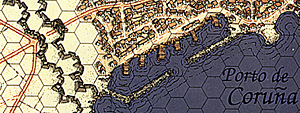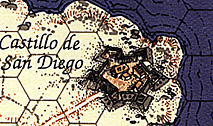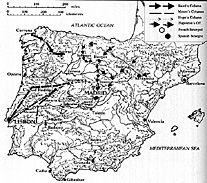
Designers: Tom Bailey, from an original concept by Laurence Groves, Monte Mattson and Dennis Spors.
Developer: Ed Wimble
Number of Players: 2, though subordinate commands might be assigned. Solitaire play also works well, but only because of the small size of the battle simulated.
Playing Time: The smallest scenario will take about 2-3 hours to play.
Complexity Level: High moderate to advanced and not recommended for beginners.
Packaging: Cardboard box with multicolor cover.
Scale: Tactical with units representing infantry regiments/battalions or skirmish companies, cavalry regiments and artillery batteries. Each strength point represents 100 infantrymen, 50 cavalrymen or a section of 2-4 guns. Ground scale is 125 meters per hexagon with each turn covering 20 minutes of time.
Maps: The two 34-by-22-inch maps are drawn in shades of brown, gold, gray and blue and are designed to give the impression of 19th Century or earlier style maps. The map is presented as if it were copied somewhat from oblique aerial imagery, rather than the usual straight vertical position. All place names and geographic locations are given in Spanish. The map contrasts quite nicely with the game's colorful counters. [Note: there are many individual houses and farmettes included only for decoration which affect neither movement nor line of sight. There are only two towns for gaming purposes: Corunna and Santa Lucia.]
 Playing Pieces: 400 cardboard 1/2-inch square counters, all back printed, which represent some 78 French and 73 Anglo-Spanish units of various sizes. There are also counters for 8 French and 7 Anglo-Spanish leaders, as well as 16 ships of the British Royal Navy (all individually named). There are a further 183+ informational counters. The counters for the military units are colored so as to resemble the uniforms of the formations they represent, though most have some form of standard NATO symbology overprinted to aid in identification of unit type -- cavalry, infantry or artillery. The counters are very colorful and quite attractive. Several units from opposing nationalities sport the same basic uniform (and counter) color. The 2nd Swiss Infantry Regiment in French service, for example, has their traditional red uniforms/counters as do most of the British foot.
Playing Pieces: 400 cardboard 1/2-inch square counters, all back printed, which represent some 78 French and 73 Anglo-Spanish units of various sizes. There are also counters for 8 French and 7 Anglo-Spanish leaders, as well as 16 ships of the British Royal Navy (all individually named). There are a further 183+ informational counters. The counters for the military units are colored so as to resemble the uniforms of the formations they represent, though most have some form of standard NATO symbology overprinted to aid in identification of unit type -- cavalry, infantry or artillery. The counters are very colorful and quite attractive. Several units from opposing nationalities sport the same basic uniform (and counter) color. The 2nd Swiss Infantry Regiment in French service, for example, has their traditional red uniforms/counters as do most of the British foot.
Rules: One 36-page Standard Rules Booklet which includes 8 full pages of Examples of Play. There is also one 24-page Exclusive Rules Booklet which includes special rules, some historical French OB's (Orders-of-Battle), comprehensive historical commentary and 5 pages of charts. Both rules booklets include an index, but the game does not use the "outline style" paragraph markings within the Standard Rules Booklet.
Other Components: Two six-sided dice, and five 8-1/2-by-11-inch sheets with charts and organizational data. For the really intrepid, one of the sheets has a draft of future 4th Edition rules changes for play testing.
Scenarios: Three, to be played separately. One is semi-historical meant as a short training game.
Historical Background Information: There is a 9-page section in the Exclusive Rules Book, with short paragraphs before each scenario as well as small descriptive sections within the body of the rules.
Publisher: Clash of Arms Games
Publication Date: 1995
Stock Number: 9503-47
List Price: $44.00 US
Summary: La Bataille des Corunna-Espagnol: January 16th, 1809 is a simulation of the battle fought between French Marshal Jean de Dieu Soult's 2nd Corps of the Army of Spain and Sir John Moore's British army near the Spanish port of Corunna. The historical contest was a 19th Century Dunkirk as the Royal Navy desperately raced against time to evacuate Moore's army in the face of determined French assaults. It is a situation that promises suspense until the last die roll of the final turn. The game plays well, if a bit slowly at times, and accurately captures the feel of Napoleonic warfare.
 It has been nearly twenty years since I first saw a La Bataille series game. In 1977 it was the classic La Bataille de la Moscowa, then already in republication by recently defunct GDW (Game Designers' Workshop). The game recreated the 1812 battle of Borodino and was one of the first so called "monster games" due to the large number of playing pieces and huge game map. It was also one of the first paper wargames to mirror the tactical considerations and morale rules found in most miniature wargames.
It has been nearly twenty years since I first saw a La Bataille series game. In 1977 it was the classic La Bataille de la Moscowa, then already in republication by recently defunct GDW (Game Designers' Workshop). The game recreated the 1812 battle of Borodino and was one of the first so called "monster games" due to the large number of playing pieces and huge game map. It was also one of the first paper wargames to mirror the tactical considerations and morale rules found in most miniature wargames.
The designers and graphic artists at Clash of Arms (COA) Games have taken the La Bataille series and carefully nurtured it. The rules remain faithful to the original design intent, but have been cleaned up and often rewritten to take advantage of advances in game mechanics. Graphics have been improved over the years to present a more colorful appearance while at the same time maintaining the Napoleonic flavor envisioned by the original authors. Historical accuracy and detail are paramount in all of COA's renditions of the La Bataille series, with several new titles being added to the already substantial list produced previously by Spors, Mattson and company.
La Bataille des Corunna-Espagnol is one of those new titles overseen by Ed Wimble of COA. The game is part of a trilogy of games on Napoleon's disastrous war in Spain (the other two are La Bataille de Talavera and La Bataille d'Albuera) and represents COA's attempt to be on the leading edge of game design in the development of the series.
The 3rd edition Standard Rules Booklet is based on the first design of the La Bataille series. Though the rules are not presented in the order of a turn sequence, they are reasonably well written and include a helpful index at the beginning of the booklet.
The Exclusive Rules Booklet is similarly well done and covers such things as the impact of certain personalities upon game play, unique terrain considerations, light infantry and naval forces employment as well as command-control restrictions. Also included are the game's three scenarios (the semi-fictional battle for the Port of Corunna, the battle of Piedralonga and the historical grand battle of Corunna), several French OB's, historical commentary and some five pages of game charts. A suggestion the designers might consider for future editions is to have these latter charts taken out of the booklet and reproduced for both sides as individual sheets for easier reference.
One of the first things a person will notice about Corunna's game mechanics is the concept of Strength Points (called Increments). Strength Points represent the numerical strength of a unit, but not necessarily its combat effectiveness or morale. Numerical factors for these two attributes remain hidden from your opponent's view on the back of the counter. Stacking (i.e., the number of counters that may physically occupy a hex at the same time) is based on Strength Points rather than whole units as in other games. In clear terrain, for example, up to 18 Strength Points of infantry in line or 36 in column may occupy a single hex of clear terrain, regardless of the number of units involved.
Likewise, Strength Points directly impact on the resolution of fire and melee combat. While traditional results such as Disorder and Rout (called Plus Grande Disordre) are used in the game, losses are also taken on a Strength Point basis with corresponding reductions in unit competency and morale. In Corunna, the loss to French or British units of an even number of Strength Points due to fire also demands the player check the affected unit's morale. Spanish units in Corunna, by the way, check morale every time they are shot at, making their employment a bit dicey considering heavy cannon have a range of 11 hexes in the game (musket range, by comparison, is a single hexagon).
The conduct of the game follows a strict Sequence of Play. The phasing player (i.e., the player whose turn it is) first declares then executes all his cavalry charges, resolving any resulting melees. Next all infantry, cavalry or artillery units that did not previously execute a charge may move. At this point the non-phasing player fires defensively at any phasing unit that ends movement adjacent to one of his own pieces, the moving units returning the complement immediately after. Melees which occur because of such movement are now resolved, and units then check for restoration of good morale or for fatigue. This same sequence is then repeated by the opposing player after which a single turn is completed.
This sequence seems standard enough to lead one to believe that Corunna is little different from other wargames, but in actuality this is not the case for two reasons. The first is the fact that hidden in the Sequence of Play are many opportunities for the non-phasing player to react to or interrupt the phasing player's movement. Outside of defensive fire, the non-phasing player may in certain circumstances direct fire against an enemy unit moving within the range of its guns, but not necessarily intending to assault. This is known as Opportunity Fire. Likewise, the non-phasing player often has the ability to use his cavalry to execute immediate charges against his phasing opponent. It makes for a very non-rigid game, one where the ebb and flow of battle can suddenly change the battlefield situation on any turn.
The second distinguishing feature of the game is the immense amount of detail reflected within the game mechanics. For example, many hexagon based games specify a single methodology by which a unit's facing is determined. That is, which hexagons adjacent to a unit specify its front, rear and flanks. In the La Bataille series, however, this information might well be different depending on the type of unit in question -- light or heavy cavalry for instance -- or the specific formation a unit is deployed in. Infantry battalions which deploy in column normally face towards a hex side, for example. If the same battalion, however, were in line, it would face towards the juncture of two hexagons and might occupy more than one hex if it were large enough.
La Bataille's system is more complex than how many other wargames handle such problems (most disregard the issue, ignoring the fact that some units could not physically fit into a hex at the defined scale without spilling over into one or more adjacent hexes). This is historically accurate, however, and makes for an even more challenging game as players must deal with the same battlefield maneuver dilemmas that their historical counterparts faced.
Games must abstract the action of combat, but La Bataille's system gives realistic results. Normal melee does not simply involve moving one counter adjacent to another, comparing opposing strengths to obtain numerical odds and then rolling a die. Instead, a single assault might involve up to eight different die rolls, producing numerous historically similar tactical results. While this makes for a complex game, dramatic situations arise each and every turn. Fortunately, the examples of play help to resolve any confusion that might come up concerning combat and several other aspects of play.
The Exclusive Rules Booklet adds additional detail, all tailored to the specific engagement being simulated (in this case Corunna). This insures that although they all use the same basic rules, each game in the series is not merely a copy of the previous release with different counters and map. It was good to see a refined command-control system within the Exclusive Rules, though I prefer an orders-based method as opposed to the distance-based system employed.
To elaborate, French units must be within a specified number of hexagons from its divisional commander to be considered "In Command" and thus have the ability to move and fight normally. The divisional commander, in turn, must also be within a specified number of hexes of Marshal Soult. In the event a cavalry leader finds himself "Out of Command," he must make a die roll less than or equal to his melee bonus number in order to move and fight normally. Infantry divisional commanders must do likewise, but only if Marshal Soult is unavailable due to wounds or other unexpected events.
British command-control is handled a bit differently. Each turn the British player must designate a single battalion in each brigade as holding the "Brigade Colors" (indicated by attractive Union Jack counters which represents the brigade commander and his staff). British battalions within two hexes of the Brigade Colors are considered "In Command" and may move and fight normally. However, in order for the Brigade Colors, and the unit with it, to move and function, either Sir John Moore must have passed through it at the beginning of the turn, or the division commander must be currently stacked in the hex with it.
The concept of basing British command on the physical presence of a leader is a novel approach that accurately reflects British efforts to compensate for the lack of a formal staff system. Overall, each set of command procedures force both sides to keep their headquarters and command staffs intact and often prevents quick reaction to enemy intentions. Historically, this is appropriate for the age of warfare before the radio and armored vehicles.
Although not recommended for beginners, the wealth of detail and historical "flavor" of La Bataille des Corunna-Espagnol can be captivating. It is their continued dedication to historical accuracy that remains Clash of Arms' greatest strength. Suffice it to say that players who complete a sitting of La Bataille des Corunna-Espagnol should not be surprised if they mistake a slight tinge of gunpowder in the air.

Back to Table of Contents -- Napoleon #6
© Copyright 1996 by Emperor's Press.
This article appears in MagWeb (Magazine Web) on the Internet World Wide Web.
The full text and graphics from other military history magazines and gaming magazines are available at http://www.magweb.com